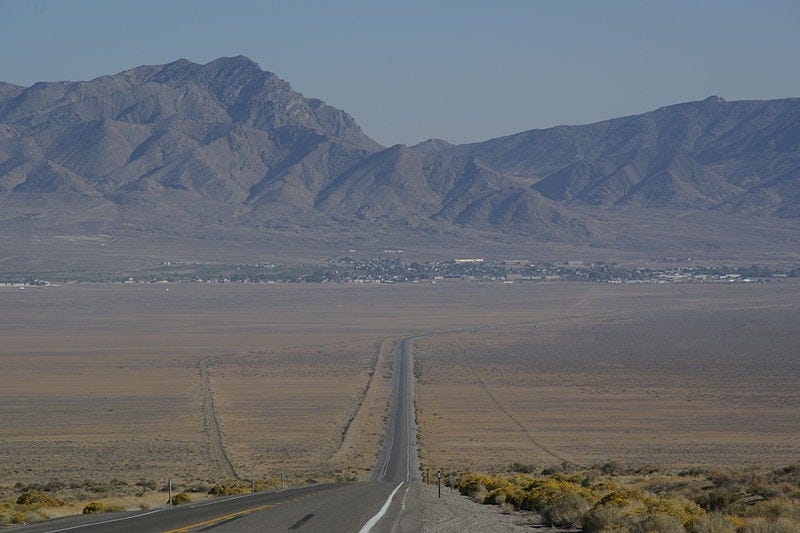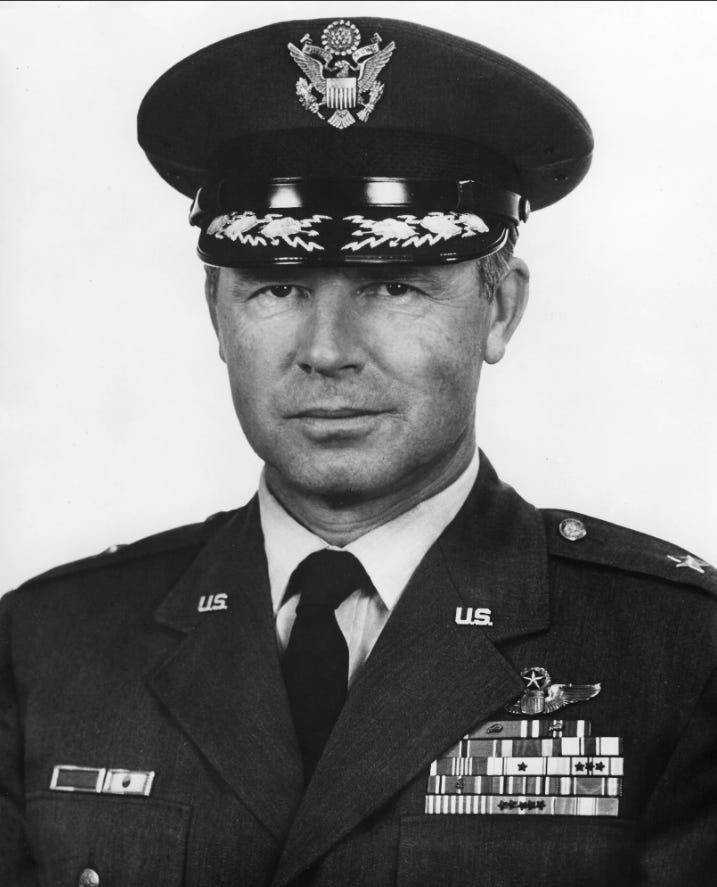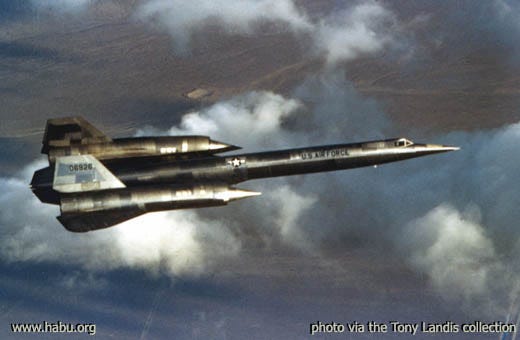Utah's Roswell Incident
On the cloudy morning of May 24, 1963, fourteen miles outside Wendover, Utah, a man fell from the sky.
As he hit the ground and his parachute deflated, he checked his surroundings. Remarkably, despite landing in a sagebrush desert, he saw a dust cloud in the distance. Three ranchers were approaching in a pickup truck. They had seen the parachute and had come to investigate.
When the truck pulled up, the ranchers, seeing the man’s flight suit, asked if they could help him locate his airplane. The ranchers had already recovered a chunk of the wreckage.
There’s been an accident, the man said, I was flying an F-105, and there was a nuclear bomb onboard.
Wendover, Utah
Wendover was no stranger to aerial weirdness. The little town straddling the Nevada border was on the opposite side of the Great Salt Lake from Salt Lake City. Reaching the population hub required a two-hour drive, most of it across the otherworldly moonscape of the Bonneville Salt Flats. Surrounding the town is miles and miles of unforgiving desert.
The remote location and desolate landscape made it ideal for isolationists and the United States Air Force who, as any student of aviation history knows, loves using vacant desert areas for their various schemes.
During World War II, Wendover housed an Army Air Field. Before shipping off to the air war over Europe, B-17 and B-24 bomber crews learned the basics of strategic bombing, formation keeping, and defensive techniques while flying over the hard-baked wasteland. Out there, a mishap wouldn’t endanger the vast suburban tracts of the Wasatch Front.
By late 1944 all the bomber squadrons had moved on to combat operations, and a new unit arrived: the 509th Composite Group. Base secrecy ramped up as gleaming silver B-29s roared down from the skies, along with various support aircraft.
The B-29, at the time, was the most advanced bomber aircraft in the United States military, possibly in the world. But these B-29s were special. Called the Silverplate B-29s, they had been extensively modified for one specific mission: dropping the atomic bomb. The pilots of the Silverplate B-29s practiced attack runs in the Utah desert before eventually dropping The Bomb over Japan.
As the war ended, testing at Wendover wound down. The newly formed USAF established new testing facilities on a remote dry lake bed 4 hours (by car) southwest of Wendover: Groom Lake, AKA Area 51.
After a few years of silent skies, and with the Cold War heating up, strange shapes again appeared over the lonely Wendover deserts.
Coverup
Within hours of the ranchers’ strange encounter, Wendover became a hotbed of activity. Military convoys appeared, planes zoomed overhead, and nobody would explain what was going on.
The man who fell to Earth — Ken Collins — wasn’t forthcoming either, evasively giving few details about what exactly he was doing in the air. Given Wendover’s history, the threat of a nuclear incident was enough to get Collins’ rescuers moving in the right direction. He insisted that the ranchers drop him off at the nearest highway patrol office so he could make a call. They did, and within two hours, a big Constellation quad-prop airliner landed at Wendover, taking Collins away to New Mexico.
Shortly after the Constellation took off, more airplanes arrived. A JetStar business jet landed, carrying Kelly Johnson, the legendary Lockheed aircraft engineer. A massive double-decker C-124 Globemaster II cargo plane touched down, filled with crew and equipment. A gleaming, metallic T-33 Shooting Star jet trainer circled the desert, the pilots taking pictures of something on the ground.
Central Intelligence Agency personnel took control of the scene. Documents call the ground commander simply “The Commander.” Brigadier General Boyd Hubbard Jr., commander of the 4520th Combat Crew Training Wing — an F-105 and F-100 training unit out of Nellis AFB, Las Vegas — coordinated operations from the top.
Extra recovery machinery arrived from Hill Air Force Base, just north of Salt Lake City. Nobody told the crews what had crashed, only that secrecy must be maintained. Despite being the nearest major air base, Hubbard deliberately kept Hill AFB in the dark.
By nightfall, the recovery crews headed into the desert. The area was so remote that they couldn’t set up light sources, and some equipment couldn’t handle the terrain. As an interim measure, the soldiers covered the wreckage with tarps. Kelly Johnson recommended dynamiting the whole area, but the CIA consultants talked him down.
CIA agents began monitoring phone lines and newspaper clippings throughout the Mountain West, looking for potential leaks. News travels fast, especially when that news involves mysterious men parachuting from the sky and nuclear bomb threats.
Hubbard created a cover story. They settled on telling the Las Vegas Review-Journal that a Republic F-105 Thunderchief out of Nellis AFB had crashed en route to the Wright-Patterson AFB in Ohio. On board was a Hughes aviation employee testing electronic components.
Hilariously, documents show there was some confusion about which version of the F-105 to use in the cover story. Republic was developing a two-seat variant of the jet, the F-105F. For some reason, the CIA higher-ups thought using the F-105F in their cover story would be more plausible, but had to switch back to the single-seat version when they discovered that Republic had not, in fact, completed development of the two-seater.
Vegas was squared away, but local Utah news was a problem. Highway patrol officers had reported the downed pilot on their radios, letting anybody with a police scanner eavesdrop.
Deseret News and Salt Lake Press News demanded information first and were told to contact Hill AFB. You’ll remember that Hill AFB was purposefully kept in the dark, wrapping those two news agencies into a cover-up loop. There was a “one press type” in Toole, Utah that agents were monitoring. This reporter remains unnamed, but I like the implication that Toole had only one solitary reporter in the whole town.
At some point during the day, Hubbard received a call from Art Kent, a reporter for KUTV. Kent had been monitoring a police scanner when he heard about the crash. He rushed to the nearest civilian airfield, rented an airplane and pilot, and took off to Wendover. Circling over the crash site, in the middle of restricted airspace, Kent photographed the wreckage. He was calling to get more information on what he had seen.
CIA agents rushed to contact Kent and get the film. At 2:00 AM, two security officers showed up at Kent’s house. Utilizing a “low-key approach," the officers explained to Kent that his photos could compromise national security. Kent, being an ex-cop, was willing to cooperate. The only catch: Kent wouldn’t name his pilot, seeing as they had entered restricted airspace. The CIA agents agreed, took the film, reimbursed Kent $60, and left. Damage control completed by 5:00 AM. When the film was developed nothing was visible, anyways.
As the sun rose on May 25th, recovery crews finally began returning to Wendover with wreckage. Two C-124s and a Constellation landed. All the material was packed away, flown off to Area 51, and that was that. A few days of cleaning the area later and Wendover went back to its sleepy self.
The only thing left to do was get the story from Ken Collins. Under hypnosis and sodium amytal, he told investigators what occurred in the sky. For the next four decades, nobody outside of a few Air Force and CIA officers knew what had happened.
Truth
Rewind to the 1950s.
Locked in the Cold War, the United States intelligence agencies needed reconnaissance photography of Soviet military facilities. Spy satellites didn’t have the capability yet, so they needed an airplane. To this end, Lockheed developed the U-2, a high-altitude spy plane. Flying at the extreme height of 80,000 feet, the U-2 was supposed to be invisible to Soviet radars. Even if the Soviets tracked the plane, their missiles and interceptors couldn’t reach it.
That was the plan, at least until the Soviets shot one down.
The CIA needed something better. For the next spy plane, Lockheed and the CIA looked to speed as the defense. The U-2 flew high, but it flew slow, being little more than a powered glider. Height plus speed was the ticket.
The CIA began developing super-fast spy planes under the Archangel program. Secrecy was the priority. Not only were the US engineers developing a plane on the cutting-edge of aviation technology, but the US also wasn’t at war with the Soviet Union and thus wasn’t supposed to be infiltrating their airspace.
After eleven iterations of the Archangel design, the CIA settled on the Lockheed A-12, designed by Kelly Johnson at his secretive Skunk Works facility. The A-12 was a lightning-fast twin-engine spy plane with a unique arrowhead planform. No other airplane looked like it. Cruising at 85,000 feet and breaking Mach 3 during operation, the A-12 was the most advanced plane in the world — the CIA didn’t want anybody to know about it.
Groom Lake (Area 51) and the surrounding Nevada/Utah desert was the perfect place to test these new airplanes. Few people lived in the wasteland, and those who did had few connections to the outside world. And, hey, if some ranchers start talking about bizarre triangular vehicles in the sky, and the press picks up the story, and everybody calls it a UFO sighting, that’s preferable to the public knowing what was actually going on.
Ken Collins was piloting an A-12 on May 24, 1963, conducting a subsonic engine test over Wendover. A-12 pilots would don pressure suits that looked like astronaut spacesuits during flight operations. At their usual operating altitude near the edge of space, a cabin depressurization would kill a pilot without a space suit in a few seconds.
Since Collins wasn’t flying at 85,000 feet, he was wearing a standard flight suit, which helped the CIA develop its cover story later. While a pilot crashing in the desert was weird, a man in a spacesuit descending on a parachute would have been positively otherworldly for those bewildered ranchers, making the cover story of an F-105 crash less believable.
Collins flew with an F-101 Voodoo chase plane piloted by Jack Weeks. As they entered a cloud bank Weeks reported that they were cruising too slowly for the F-101 to maintain stable flight. The A-12’s instruments showed a different airspeed than Weeks was reporting. Weeks peeled off while Collins stayed level to figure out the problem.
As Collins started troubleshooting, the airspeed indicator fell rapidly. Collins was in a cloud bank — there was no visual reference to indicate his true airspeed. Suddenly, the nose of the A-12 pitched up and flipped over, inverting the airplane. Now upside down, the A-12 began spinning around its vertical axis, placing Collins into a pilot’s nightmare: an inverted flat spin. Imagine how a leaf flutters to the ground, but picture yourself strapped upside down on it, and that instead of a leaf, it’s a supersonic recon jet.
There was no way to recover, so Collins punched out. As he descended on a parachute, he watched the A-12 spin to the ground, exploding in a fireball. The CIA’s state-of-the-art plane, a massive aerospace secret, lay burning in middle-of-nowhere Utah.
Months after the crash, investigators discovered the cause of the crash: an inadequate pitot tube sending incorrect airspeed information to the flight control computer.
The complete story of the A-12 program was classified for years. By the late 60s, the CIA didn’t have much use for the plane. It never overflew the Soviet Union. During the Vietnam War, it made recon flights, but the Vietnamese air defenses could track it. Recon satellites like the Keyhole series promised a more flexible and secure spy platform.
While the CIA didn’t have much use for the A-12 anymore, the US Air Force ordered an updated version for itself. This was the much more famous SR-71 Blackbird, which never had the same veil of secrecy the A-12 did.
The A-12 program was completely declassified in the mid-90s, and the truth about the Wendover incident was in the early-2000s. For decades the Wendover residents and Art Kent kept the fading memory of what, from their perspective, must have looked like Utah’s Roswell Incident.
Coda
Despite all the efforts, the CIA did not completely cleanse the area. In 2003 one of the declassified documents led X-plane enthusiast Pete Merlin to that lonely desert crash site. Sure enough, the impact crater was still there, an outline of the unique A-12 profile. The crater wasn’t the only thing remaining. Other aviation nerds were able to scour the area and find little bits of the A-12 that the crews in the 60s missed. For forty years, you could have wandered out of Wendover and, if lucky, grabbed a chunk of a CIA spy plane.
Sources
Some basic information about the crash
https://archive.sltrib.com/article.php?id=51976355&itype=cmsid
More details:
The Plane Itself
http://www.habu.org/a-12/06926.html
Wreckage Found:
https://www.worthpoint.com/worthopedia/a12-oxcart-123-60-6926-titanium-relic-1879583839
https://www.aircraftwrecks.com/A-12%20Article%20123.pdf
Books
X-Plane Crashes by Peter W. Merlin, Tony Moore
Black Lightning: The Legacy of the Lockheed Blackbirds by Jeannette Remak
CIA Docs
https://www.cia.gov/readingroom/docs/CIA-RDP71B00590R000200040010-0.pdf
https://www.cia.gov/readingroom/docs/CIA-RDP71B00590R000200060002-7.pdf
https://www.cia.gov/readingroom/docs/CIA-RDP71B00590R000200040004-7.pdf











